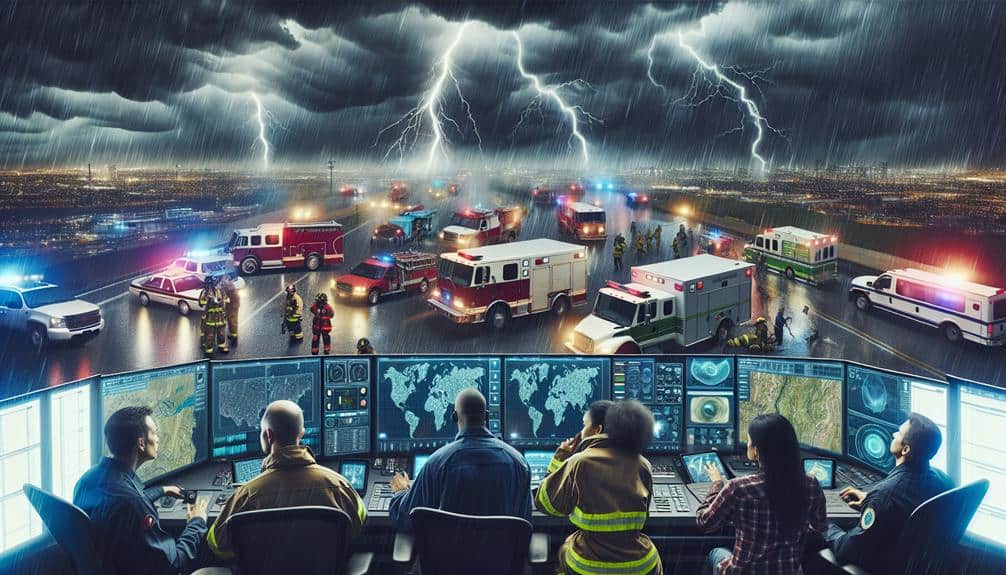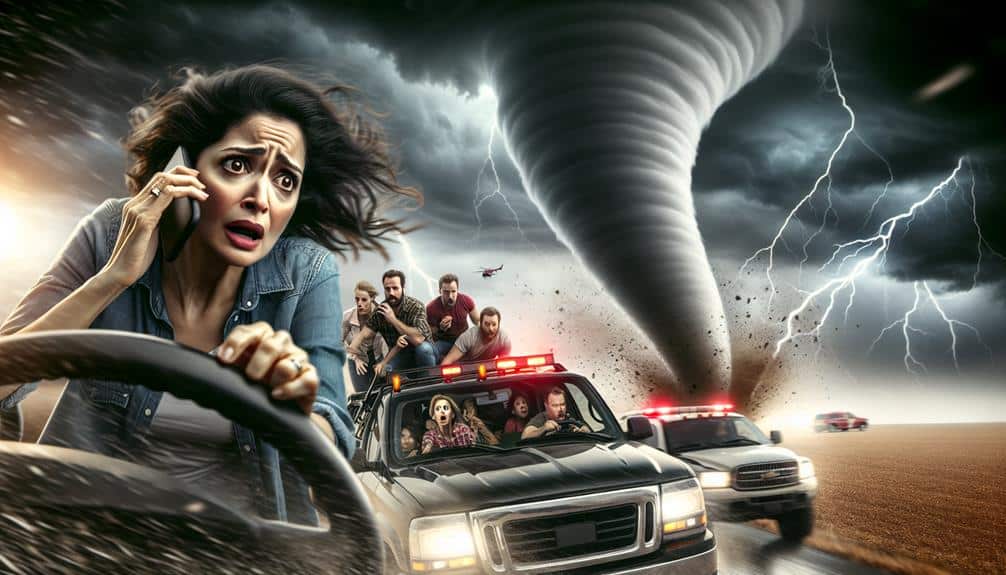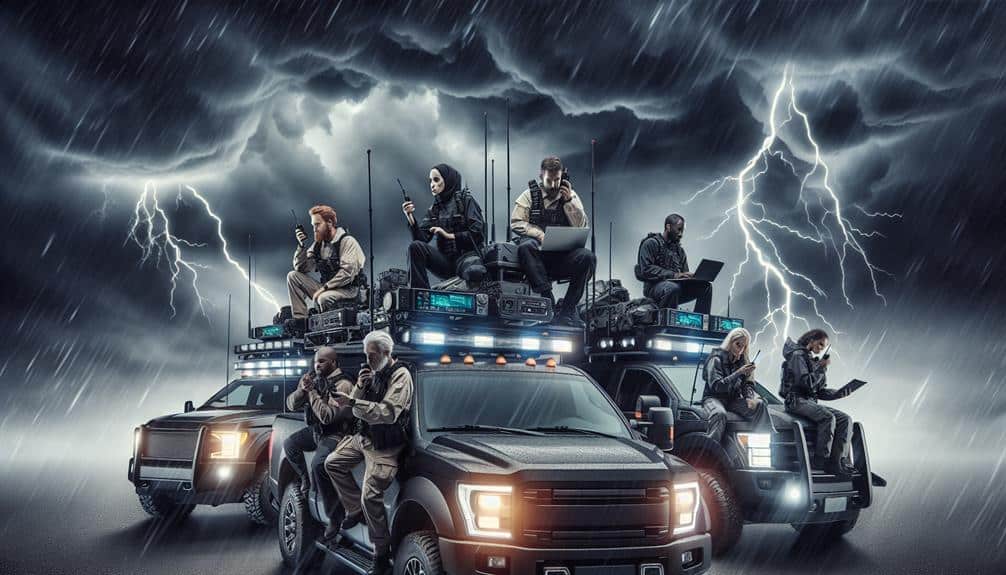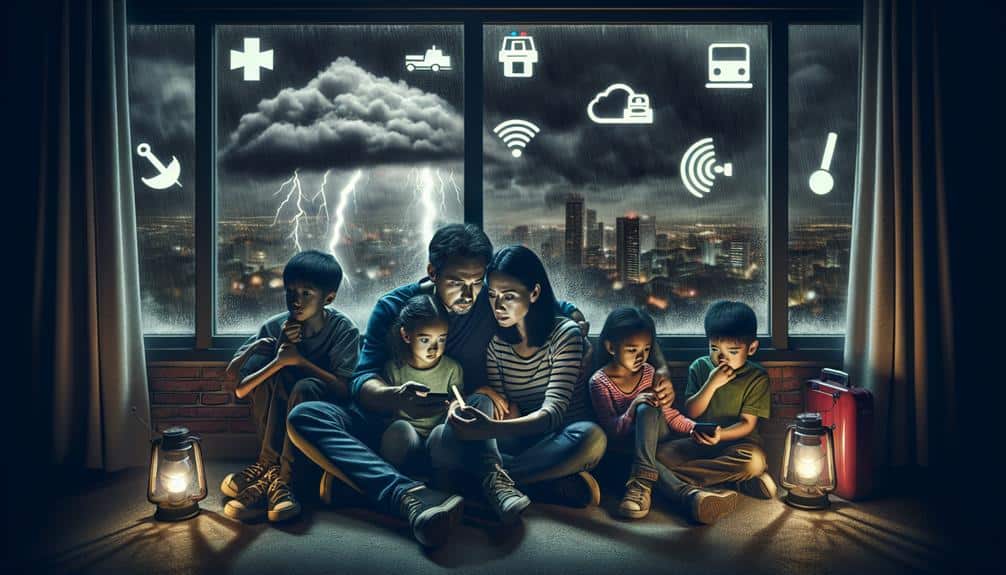We've got to standardize communication protocols and leverage advanced technologies like GIS, mobile apps, and AI-driven predictive models to streamline coordination between storm chasers and emergency personnel. Implementing satellite communications and a universal storm classification system guarantees instant comprehension of severity. Real-time data sharing, interactive training, and continuous education strengthen situational awareness. Incorporating automated alert systems and iterative feedback loops optimizes incident response. By analyzing data to identify patterns, we can forecast storm impacts more accurately. This approach not only enhances our response capabilities but also promises deeper insights into improving our strategies.
Key Points
- Implement standardized communication protocols for consistent and clear information exchange between storm chasers and emergency personnel.
- Utilize real-time data sharing platforms with user-friendly interfaces to ensure accurate and timely information flow.
- Integrate GIS and mobile communication apps to enhance situational awareness and decision-making during storm events.
- Conduct regular hands-on training and interactive simulations to improve communication skills and operational readiness.
Establishing Protocols
To optimize coordination between storm chasers and emergency personnel, we'll implement a set of standardized communication protocols based on empirical data and best practices. Our initial step in protocol development involves a thorough analysis of existing communication strategies. We'll examine case studies of both successful and problematic interactions to identify key factors that contribute to effective coordination.
We must guarantee our protocols enhance real-time data sharing and situational awareness. By using a standardized set of codes and terminology, we can reduce misunderstandings and streamline information flow. For instance, adopting a universal storm classification system will help emergency personnel understand the severity and potential impact of weather events instantly.
Moreover, we'll establish clear guidelines for when and how communication should occur. This includes predefined intervals for status updates and specific triggers for emergency alerts. By doing so, we can avoid information overload while ensuring critical data is transmitted promptly.
Utilizing Technology
Leveraging cutting-edge technology will enhance the effectiveness of communication between storm chasers and emergency personnel. By integrating advanced technologies, we can achieve significant communication enhancement and efficiency improvement.
Real-time data sharing platforms, such as Geographic Information Systems (GIS) and mobile communication apps, allow us to transmit vital information instantaneously. For example, GIS can provide detailed maps of storm paths, enabling emergency personnel to strategize resource utilization more effectively.
Furthermore, the implementation of AI-driven predictive models can offer accurate forecasts, giving us a head start in mobilizing resources and personnel. These models analyze vast amounts of meteorological data and deliver precise predictions that can be shared seamlessly between storm chasers and emergency teams. This kind of technology integration ensures that everyone is on the same page, minimizing the risk of miscommunication.
Satellite communication systems also play a pivotal role, particularly in areas where traditional networks fail. They guarantee that essential updates and alerts are transmitted without delay, thereby optimizing our operational efficiency.
Training and Education
Effective training and education programs are vital for guaranteeing storm chasers and emergency personnel can seamlessly collaborate during severe weather events. To achieve this, we need structured, data-driven approaches that foster a deep understanding of meteorological phenomena and emergency protocols. Interactive simulations and hands-on practice are crucial components of effective training.
Here's a breakdown of what our training programs should include:
- Interactive Simulations: Utilizing advanced software to simulate severe weather scenarios helps both storm chasers and emergency personnel visualize and respond to real-time threats. These simulations promote experiential learning, which is crucial for quick decision-making.
- Hands-On Practice: Real-world drills that replicate severe weather conditions allow participants to apply theoretical knowledge in a controlled setting. This enhances skill retention and practical application, guaranteeing that everyone is prepared when an actual event occurs.
- Collaborative Workshops: Joint training sessions that include both storm chasers and emergency personnel foster better communication and teamwork. These workshops can be used to discuss strategies, share experiences, and build mutual trust.
- Continuous Education: Ongoing training is necessary to keep up with evolving technology and methodologies. Regular refresher courses ensure that everyone stays up-to-date with the latest tools and techniques.
Real-Time Data Sharing
We'll enhance our response capabilities by leveraging real-time data sharing for instant weather updates and seamless information transfer.
Utilizing advanced meteorological tools, we can relay critical data to emergency personnel within seconds.
This immediate exchange of information allows for accurate, data-driven decisions that improve safety and efficiency.
Instant Weather Updates
Real-time data sharing, facilitated by advanced meteorological technology, allows storm chasers and emergency personnel to receive instant weather updates, enhancing situational awareness and decision-making. By leveraging cutting-edge weather tracking systems, we can monitor atmospheric changes in real-time, making sure everyone involved stays informed and prepared. This level of immediacy is crucial not just for safety but also for efficient resource allocation.
Our ability to coordinate communication effectively hinges on several key components:
- Live Radar Feeds: Access to continuous radar imagery enables us to track storm movements and intensity changes more accurately.
- Mobile Weather Stations: Portable units provide localized data, offering detailed insights that fixed stations might miss.
- Satellite Imagery: High-resolution satellite data helps us visualize large-scale weather patterns and predict potential developments.
- Automated Alerts: Real-time notifications make certain that all team members are promptly informed of significant weather changes.
Each of these elements plays a crucial role in enhancing our weather tracking capabilities and facilitating seamless communication coordination. By integrating these technologies, we empower ourselves to act swiftly and decisively, maximizing our operational efficiency and ensuring the safety of all parties involved.
This proactive approach aligns with our desire for autonomy and resilience in the face of unpredictable weather events.
Seamless Information Transfer
Our integrated communication network guarantees smooth information transfer, enabling real-time data sharing important for storm chasers and emergency personnel. By leveraging advanced data integration protocols, we make certain that meteorological data collected by storm chasers is instantly accessible to emergency responders. This rapid exchange of information enhances situational awareness and facilitates more proactive disaster management.
We utilize sophisticated algorithms to process and transmit data, minimizing latency and maximizing communication efficiency. For instance, GPS coordinates, wind speeds, and atmospheric pressure readings are relayed in real-time, providing a comprehensive view of storm dynamics. This continuous flow of accurate, up-to-date information supports informed decision-making and timely interventions.
Our system's robustness lies in its redundancy measures and secure channels, making sure that even in the most severe weather conditions, data integrity is maintained. By integrating various data sources—radar, satellite, and on-ground sensors—we create a unified data stream that's both reliable and actionable.
Emergency Response Plans

Frequently, emergency response plans must be carefully coordinated to guarantee seamless communication between storm chasers and emergency personnel. By focusing on collaborative strategies and effective communication, we can enhance our response to severe weather events. Data shows that well-coordinated efforts notably reduce response times and improve situational awareness.
To achieve this, our emergency response plans should include:
- Unified Communication Channels: Establishing a single platform for storm chasers and emergency personnel ensures that critical information is shared instantly and accurately.
- Real-time Data Integration: Utilizing advanced technology to integrate real-time weather data from storm chasers into emergency operations centers enhances decision-making processes.
- Role-specific Protocols: Defining clear roles and responsibilities for both storm chasers and emergency personnel reduces confusion and streamlines operations during emergencies.
- Regular Training and Simulations: Conducting joint training sessions and simulations helps both groups familiarize themselves with each other's procedures, fostering trust and improving operational efficiency.
Feedback and Improvement
We need to improve real-time reporting channels to guarantee accurate and timely information flow between storm chasers and emergency personnel.
By optimizing incident response through targeted feedback loops, we can enhance our overall efficiency and effectiveness.
Additionally, utilizing advanced data analysis techniques will enable us to identify patterns and make informed decisions for future storm events.
Real-time Reporting Channels
Real-time reporting channels need continuous feedback and iterative improvements to guarantee efficient communication between storm chasers and emergency personnel. By leveraging direct messaging and live updates, we can streamline the flow of critical information. To achieve this, we must focus on several key aspects:
1. Accuracy of Information:
Making sure that the data shared via direct messaging and live updates is precise and timely is essential. This minimizes the risk of misinformation and enhances situational awareness for emergency personnel.
2. User-Friendly Interfaces:
Simplified interfaces for both storm chasers and emergency responders can reduce the time spent finding their way through the system, allowing for quicker data sharing and responses. User feedback should guide these improvements.
3. Network Reliability:
Strong infrastructure that supports uninterrupted communication, even in the most adverse conditions, is necessary. Regular testing and updates can help maintain network integrity.
4. Training and Protocols:
Ongoing training programs for storm chasers and emergency personnel ensure that everyone is familiar with the latest reporting tools and protocols. This promotes a seamless and efficient communication process.
Incident Response Optimization
Optimizing incident response demands a data-driven approach that incorporates continuous feedback and iterative improvements to refine our communication strategies. By leveraging real-time data analytics, we can identify bottlenecks and inefficiencies in our current systems. This not only enhances our response times but also guarantees that critical information is disseminated swiftly and accurately.
A focus on efficiency enhancement allows us to streamline our operations. For instance, integrating automated alert systems with manual reporting can drastically reduce delays. Feedback from both storm chasers and emergency personnel provides invaluable insights into which aspects of our communication coordination need refinement. By acting on this feedback, we can implement targeted changes that yield measurable improvements.
Moreover, iterative improvements necessitate a cyclical process where we continuously assess our performance, apply modifications, and re-evaluate outcomes. This approach guarantees that our strategies are dynamic and adaptable, meeting the evolving demands of emergency scenarios.
Enhanced communication coordination between storm chasers and emergency personnel hinges on our commitment to this process. Constantly refining our methods based on real-world experiences allows us to maintain a high level of operational readiness and effectiveness, ultimately safeguarding lives and property more efficiently.
Data Analysis Techniques
Harnessing advanced data analysis techniques allows us to transform raw feedback into actionable insights, driving continuous improvement in our communication strategies. By leveraging sophisticated tools, we can analyze patterns and trends that inform our decision-making processes.
Data Visualization and Trend Analysis:
Visualizing data through graphs and charts allows us to quickly identify patterns in storm chaser reports and emergency responses. Trend analysis helps us pinpoint the most effective communication methods, guaranteeing that critical information is relayed efficiently.
Predictive Modeling and Risk Assessment:
Using predictive modeling, we can forecast potential storm patterns and their likely impact zones. This enables us to conduct risk assessments and prepare emergency personnel more effectively, minimizing potential damages and enhancing safety measures.
Feedback Loop Implementation:
By incorporating a continuous feedback loop, we make sure that data from each storm event is analyzed and utilized to refine our strategies. This iterative process promotes ongoing improvement and adaptability in our communication systems.
Automated Data Collection:
Implementing automated systems for collecting real-time data from storm chasers and emergency responders reduces human error and speeds up the dissemination of critical information. Automation frees up resources, allowing us to focus on strategic planning and response coordination.
Frequently Asked Questions
What Qualifications Are Required to Become a Storm Chaser?
We need a solid education in meteorology, physics, or atmospheric science. Experience in fieldwork and data analysis is essential. Training programs and certifications enhance our skills, ensuring we can independently pursue our passion for storm chasing.
How Can the General Public Stay Informed About Storm Chaser Activities?
Staying informed about storm chaser activities is like having a front-row seat to nature's theater. We leverage public engagement through advanced communication platforms, ensuring real-time updates and data-driven insights to keep everyone aware and prepared.
Are There Any Legal Restrictions on Storm Chasing?
We must consider legal limitations and ethical concerns in storm chasing. While no federal laws specifically restrict it, local regulations may apply. Ensuring safety and respecting property rights are essential to maintaining our freedom in this field.
How Do Storm Chasers Fund Their Operations?
We fund our storm chasing operations through diverse funding sources, including grants, personal savings, and sponsorship opportunities. Analyzing data, we identify potential sponsors and optimize our budget to guarantee financial sustainability and operational freedom.
What Are the Primary Motivations for Individuals to Become Storm Chasers?
Picture us in the heart of a storm, chasing thrills while contributing to scientific research. Our primary motivations include adrenaline, data collection, and advancing meteorological understanding. We pursue freedom in the chaos of nature's most extreme events.


